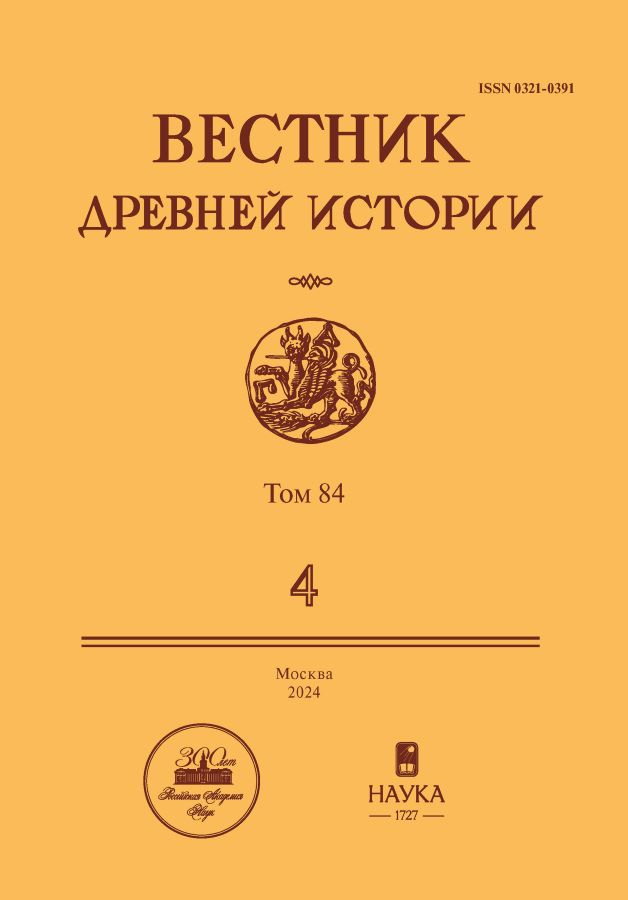The Role of Birds in the Myth of Remus and Romulus
- Авторлар: Mosolkin A.V.1
-
Мекемелер:
- Lomonosov Moscow State University
- Шығарылым: Том 84, № 4 (2024)
- Беттер: 956-974
- Бөлім: Articles
- URL: https://ter-arkhiv.ru/0321-0391/article/view/681251
- DOI: https://doi.org/10.31857/S0321039124040055
- ID: 681251
Дәйексөз келтіру
Аннотация
The article examines mentions of birds – mostly the woodpecker – in the myth of Remus and Romulus according to literary and iconographic sources. The presence of the woodpecker in the story is apparently redundant. The first appearance of birds in this myth probably had an augural meaning, which over time was either forgotten or lost its sense, and the woodpecker itself became the bird of Mars.
Негізгі сөздер
Толық мәтін
Авторлар туралы
Alexey Mosolkin
Lomonosov Moscow State University
Хат алмасуға жауапты Автор.
Email: mosolkin@mail.ru
ORCID iD: 0009-0004-1314-3673
кандидат исторических наук, доцент кафедры древних языков исторического факультета
Ресей, MoscowӘдебиет тізімі
- Alföldi, A. 1965: Early Rome and the Latins. Ann Arbor.
- Ampolo, C., Manfredini, M. (a cura di) 1988: Plutarco. Le vite di Teseo e di Romolo. Milano.
- Ancillotti, A., Cerri, R. 2023: Le Tavole di Gubbio e l’Italia preromana. Perugia.
- Arnott, W.G. 2007: Birds in the Ancient World from A to Z. London–New York.
- Brelich, A. 2010: Tre variazioni romane sul tema delle origini. Roma.
- Brind’Amour, L., Brind’Amour, P. 1975: Le dies lustricus, les oiseaux, de l’aurore et l’amphidromie. Latomus 34, 17–58.
- Briquel, D. 1976: L’oiseau omnial, la louve de Mars, la truie féconde. Mélanges de l’École française de Rome. Antiquité 88/1, 31–50.
- Briquel, D. 2018: Romulus, jumeau et roi. Réalités d'une légende. Paris.
- Capponi, F. 1979: Ornithologia Latina. Genova.
- Carandini, A. (ed.) 2006a: La leggenda di Roma. Vol. I. Dalla nascita dei gemelli alla fondazione della città. Milano.
- Carandini, A. 2006b: Remo e Romolo. Dai rioni dei Quiriti alla città dei Romani (775/750–700/675 a.C. circa). Torino.
- Coarelli, F. 2011: Le origini di Roma. Milano.
- D’Anna, G. (ed.) 1997: Anonimo. Origine del popolo romano. Milano.
- Dardenay, A. 2010: Les mythes fondateurs de Rome: images et politique dans l’Occident romain. Paris.
- Dardenay, A. 2012: Images des fondateurs. D’Énée à Romulus. Bordeaux.
- Devoto, G. 1974: Le tavole di Gubbio. Firenze.
- Dillon, M. 2017: Omens and Oracles. Divination in Ancient Greece. London–New York.
- Dulière, C. 1979: Lupa Romana. Recherches d’iconographie et essai d’interprétation. Vol. I–II. Bruxelles–Rome.
- Dumézil, G. 1970: Archaic Roman Religion. Vol. I–II. Baltimore–London.
- Ernout, A., Meillet, A. 1939: Dictionnaire étymologique de la langue latine. Paris.
- Furtwängler, A. 1900: Die Antike Gemmen. Geschichte der Steinschneidekunst im Klassischen Altertum. Bd. II. Berlin.
- Gabba, E. 2000: Roma arcaica. Storia e storiografia. Roma.
- Gasparri, C., Paris, R. (eds.) 2013: Palazzo Massimo alle terme. Le collezione. Roma.
- Green, A. 2023: Birds in Roman Life and Myth. London–New York.
- Halliwell-Phillips, J.O. 1847: A Dictionary of Archaic and Provincial Words, Obsolete Phrases, Proverbs and Ancient Customs from the Fourteenth Century. London.
- Harris, R. 1916: Picus Who Is Also Zeus. Cambridge.
- Krappe, A.H. 1941: Picus Who Is Also Zeus. Mnemosyne 9/4, 241–257.
- Mazzarino, S. 1966: Il pensiero storico classico. Vol. 1. Roma–Bari.
- Mazzoleni, D., Pappalardo, U. 2004: Fresques des villas romaines. Paris.
- Nash, D.E.M. 1988: Feronia. Lexicon Iconographicum Mythologiae Classicae 4/1, 132–133.
- Pairault Massa, F.-H. 1992: Iconologia e politica nell’Italia antica: Roma, Lazio, Etruria dal VII all Secolo a.C. Milano.
- Parisi Presicce, C. 2000: La lupa Capitolina. Roma.
- Podossinov, A.V. 1999: Ex oriente lux! Orientatsiya po stranam sveta v arkhaicheskikh kul’turakh Evrazii [Ex oriente lux! Orientation on Cardinal Directions in Archaic Cultures of Eurasia]. Moscow. Подосинов, А.В. Ex oriente lux! Ориентация по странам света в архаических культурах Евразии. М.
- Pollard, J.R.T. 1948: The Birds of Aristophanes. A Source Book for Old Beliefs. American Journal of Philology 69, 353–376.
- Poucet, J. 1976: Fabius Pictor et Denys d’Halicarnasse: «Les enfances de Romulus et Rémus». Historia: Zeitschrift für Alte Geschichte 25/2, 201–216.
- Poultney, J.W. 1959: The Bronze Tables of Iguvium. Baltimore–Oxford.
- Richard, J.-C. 1983: Pseudo-Aurélius. Les origines du peuple romain. Texte établi, traduit et commenté. Paris.
- Small, J.P. 1988: Faustulus. Lexicon Iconographicum Mythologiae Classicae 4/1, 130–132.
- Smorchkov, A.M. 2024: [The Statue and the Cult: The Wolf/She-wolf in the Public Religion and Folk Beliefs of Ancient Rome]. In: N.V. Bugaeva (ed.), Carmina saecularia. Materialy conferentsii pamyati I.L. Mayak [Carmina saecularia. Proceedings of the Conference in memoriam of Iya Leonidovna Mayak]. Moscow, 47–60. Сморчков, А.М. Статуя и культ: волк/волчица в общественной религии и народных верованиях древнего Рима. В сб.: Н.В. Бугаева (ред.), Carmina saecularia. Материалы конференции памяти И.Л. Маяк. М., 47–60.
- Solopov, A.I. 1990: [About One of the Augur Birds (Meaning of the Word parra)]. In: Yazyki i kul’tury v antichnosti [The Languages and the Cultures in the Ancient World]. Moscow, 24–25. Солопов, А.И. Об одной из авгурских птиц (значение слова parra). В сб.: Языки и культуры в античности. М., 24–25.
- Vasmer, M. 1986: Etimologicheskiy slovar’ russkogo yazyka [The Etymological Dictionary of the Russian Language]. Vol. I–IV. Moscow. Фасмер, М. Этимологический словарь русского языка. T. 1–4. М.
- Winkler, H., Christie, D.A., Nurney, D. 1995: Woodpeckers. A Guide to the Woodpeckers of the World. New York.
Қосымша файлдар


























